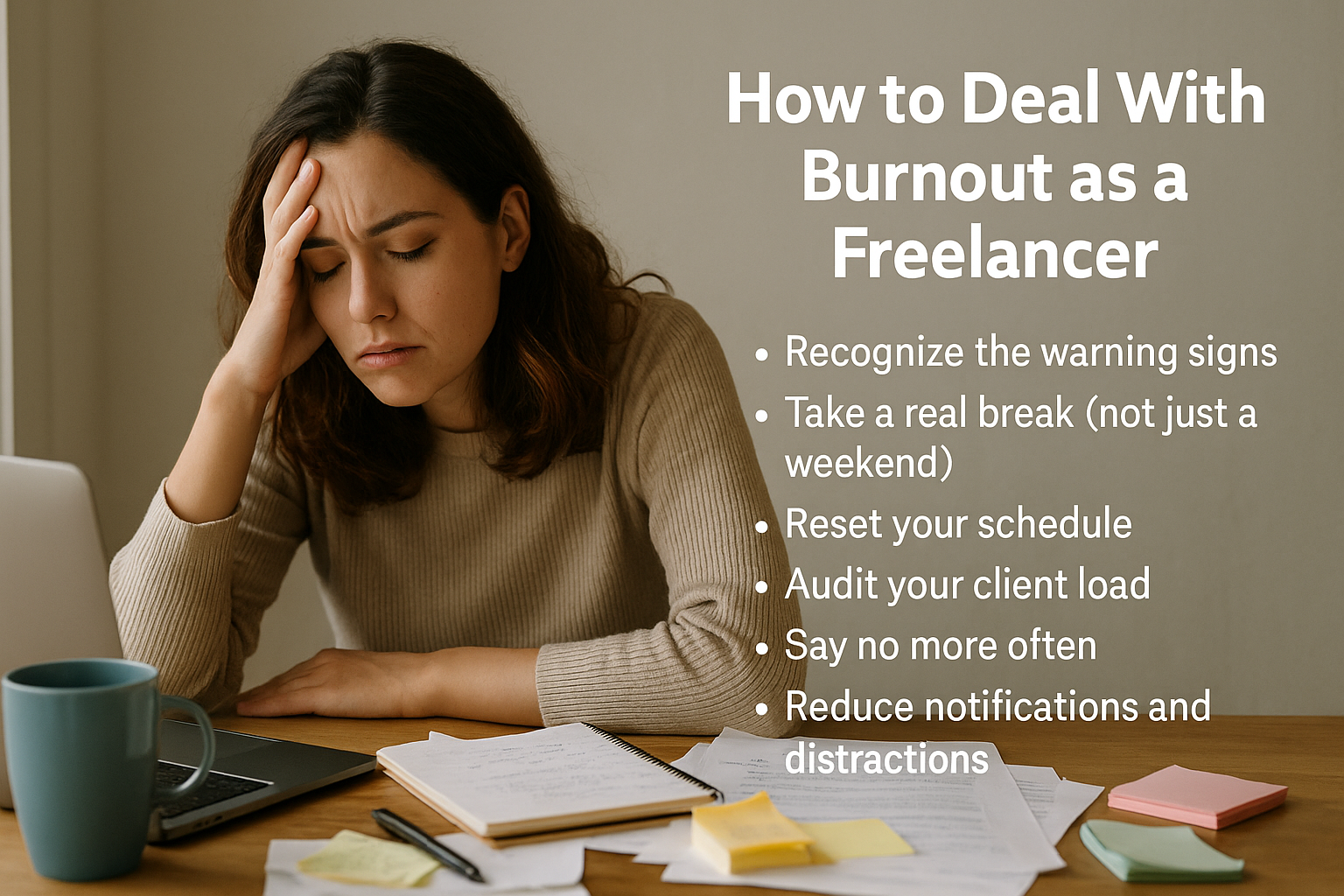Freelancing can be incredibly rewarding—but also incredibly exhausting. When you’re juggling deadlines, clients, marketing, admin tasks, and personal responsibilities, it’s easy to feel overwhelmed. That’s when burnout creeps in. And unlike a traditional job, there’s no sick leave or HR department to catch you when you crash. In this article, you’ll learn how to recognize, recover from, and prevent burnout as a freelancer, so you can keep building your business without sacrificing your well-being.
What Is Freelancer Burnout?
Burnout is a state of emotional, physical, and mental exhaustion caused by prolonged stress or overwork. It often shows up as:
- Lack of motivation
- Feeling emotionally drained
- Trouble concentrating
- Low productivity
- Irritability or anxiety
- Avoiding work altogether
If you feel like you’re pushing yourself every day but getting nowhere, you might be burning out.
Why Freelancers Are Especially Prone to Burnout
Unlike employees, freelancers face unique pressures:
✅ Inconsistent income
✅ No team support
✅ Client pressure and scope creep
✅ Fear of saying no
✅ Pressure to be “always on”
✅ Lack of routine or boundaries
It’s easy to work all the time—and never feel like it’s enough.
Step 1: Recognize the Warning Signs
Burnout often builds slowly. Pay attention to signs like:
- Constant fatigue, even after sleeping
- Dreading client messages or projects
- Resenting your work or clients
- Struggling to focus on simple tasks
- Feeling stuck in a cycle of “busy but not productive”
Acknowledging burnout is the first step to healing it.
Step 2: Take a Real Break (Not Just a Weekend)
If you’re deep in burnout, you need to step away and recharge—not just rest for one day.
Try:
- A week off with no work or social media
- A 3-day weekend without your laptop
- A full day of rest and reflection
- A “client pause” with light auto-reply
Even a short break can help your nervous system reset.
Step 3: Reset Your Schedule
Once you’ve rested, it’s time to rebuild your routine intentionally.
Ask:
- What tasks drain me the most?
- When do I feel most energized?
- What would a healthy, sustainable day look like?
Build a work rhythm that includes:
✅ Focus blocks
✅ Breaks
✅ Clear stop times
✅ Time for life outside work
Step 4: Audit Your Client Load
Some burnout comes from working with the wrong clients—or too many of them.
Review:
- Who pays the least but expects the most?
- Who drains your energy with poor communication?
- Which projects are exciting vs. exhausting?
It’s okay to let go of low-alignment clients to protect your mental health.
Step 5: Say No More Often
Burnout often comes from people-pleasing. Start saying no with confidence.
What to say:
- “I’m fully booked right now.”
- “That’s outside the scope of our agreement.”
- “I can take this on starting next month.”
- “This isn’t a great fit for me, but I can recommend someone else.”
Every no creates space for a better yes.
Step 6: Reduce Notifications and Distractions
Constant pings and alerts keep you in stress mode. Reclaim your focus.
- Turn off non-urgent notifications
- Check email only at set times
- Mute chats during work blocks
- Use “Do Not Disturb” for deep work
A calmer workspace = a calmer mind.
Step 7: Move Your Body and Get Outside
Burnout isn’t just in your head—it’s in your body. Physical movement helps clear mental stress.
- Go for a 10-minute walk
- Stretch between meetings
- Try yoga or gentle exercise
- Sit outside with no phone
Nature and movement are medicine.
Step 8: Reconnect With Your “Why”
Burnout can make you forget why you started freelancing. Reignite your purpose.
Ask:
- What do I love about my work?
- What impact am I creating for clients?
- What kind of life am I building?
Reconnect with your vision—and adjust your path if needed.
Step 9: Talk to Someone
Don’t isolate yourself in burnout. Support helps.
- Talk to a freelancer friend
- Join a support group
- Hire a coach or therapist
- Share your experience online (you’re not alone!)
Speaking it out helps you move through it.
Step 10: Prevent Future Burnout With Systems
Once you’ve recovered, protect your energy going forward.
✅ Use templates and SOPs
✅ Batch your work
✅ Set clear working hours
✅ Schedule regular breaks and vacations
✅ Prioritize high-value clients
✅ Create a sustainable income goal—not a hustle goal
Your freelance business should serve your life—not consume it.
Final Thoughts: Burnout Is a Signal, Not a Failure
If you’re burned out, you haven’t failed—you’ve just pushed too hard for too long. Listen to what your mind and body are telling you. Step back. Reset. Rebuild.
Because sustainable success isn’t about doing more—it’s about doing what matters, consistently, without burning out.

